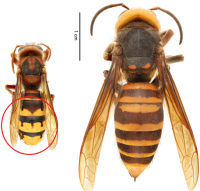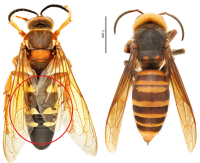Northern giant hornet (a.k.a. Asian giant hornet or “murder hornet”)
Key Points about northern giant hornet:
- Are an invasive species
- Are only known in North America to be in the Pacific Northwest
- There are native or established insects that are similar in appearance
- You may send any photos of suspected northern giant hornet to pestid@agr.georgia.gov
In the fall of 2019, the northern giant hornet (Vespa mandarinia) was found near Blaine (Washington) and in two locations in British Columbia (Canada). By the end of 2021, the Washington Department of Agriculture had located and eradicated four northern giant hornet nests. In 2022, no hornets were detected.
Distribution in North America:
The only confirmed northern giant hornet sightings in North America are in the Pacific Northwest, in the State of Washington (Whatcom County) and British Columbia (Canada).
Identification:
The northern giant hornet is the world’s largest species of hornet, measuring up to 1.5 inches. While northern giant hornets have not been found in North America except in Washington State and British Columbia (Canada), there are insects that can be mistaken for this insect. Two of the most common insects reported to our department are the European giant hornet (Vespa crabro)and the cicada killer (Sphecius speciosus).
European giant hornets (on the left) are a little smaller than the northern giant hornets (approx. 1.3 inches) and have dark “drops” that extend into the yellow bands on the abdomen (circled in red below). European giant hornets are not native to North America but were introduced in the mid-1800s. No action is taken on sightings of European giant hornets.

Photo: courtesy of Hanna Royals, USDA APHIS PPQ ITP, Bugwood.org
Another insect commonly mistaken for northern giant hornets is the common cicada killer (pictured on the left). This insect may be as large as the northern giant hornet but its black band markings extend into the yellow bands on its abdomen as well. Cicada killers are native to the U.S.

Photo: courtesy of Hanna Royals, USDA APHIS PPQ ITP, Bugwood.org
Nesting Sites:
Northern giant hornets typically build their nests underground, usually in abandoned rodent burrows in forests. Nests are sometimes constructed in dead, hollow trunks or roots of trees, but these are never more than 3 to 6 feet above the ground. Aerial nests are rare – of 1,756 nests examined in Japan, only three (or 0.17%) were constructed above ground.
Links:
https://entomology.ces.ncsu.edu/murder-hornet-comparison/


